Solar Systems
Solar PV or Photo Voltaic systems are solar systems for creating clean, sustainable and free electricity from the sun. Solar panels efficiencies are getting better every year and range from 13% to 20% on solar panels manufactured in the last couple of years.
We help you find any incentives and rebates from your State, city and local electric provider. The Federal 30% tax incentive is still in effect for another 6 years from 2016. You are able to take 30% tax write off for any complete renewable energy system ind installation costs purchased in the previous year. Find rebates and incentives for your State and City.

Residential Grid Tie Solar Electric Systems
Solar eletric for residential use connected to the grid consists of solar panels, rack or ground mounts or solar tracker, Grid Tie Inverter. No batteries needed unless customer wants to add emergency backup. Grid Tie solar is not usable if grid goes down.
Learn more
Commercial Grid Tie Solar Electric Systems
GreenTechFusion consults with larger commercial installers for commercial installations. businesses typically get more incentives and larger tax incentives for going solar. Power Purchase Agreements are better for businesses than residential customers.
Learn more
Mobile/Emergency Solar
GreenTechFusion builds custom emergency solar and hybrid wind generators for short term emergency or mobile usage as well as larger cargo trailer sized systems for use in natural disasters or events..
Learn more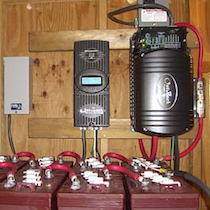
Off Grid Solar
Off Grid solar systems are for those that want 100% autonomy from the electric company and grid. Going fully Off Grid is more expensive up front due the cost of the battery bank and other required hardware not used in Grid Tie systems.
Learn more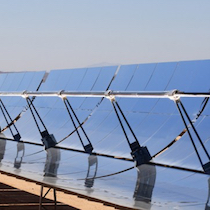
Concentrated Solar Power
Concentrated Solar systems are based on solar thermal principles and work via heat and not electricity for energy generation. Stirling engine based CSP systems that track the sun throughout the day are becoming more popular on large scale Implementations Fusce feugiat malesuada odio.
Learn more
Solar Hot Water
Solar Hot Water systems are one of the oldest solar systems and are based on solar thermal heat and not electric energy generation. Fusce feugiat malesuada odio.
Learn moreSolar Electric
Systems
As of early 2016, most U.S homeowners are paying $3 to $4 per watt to install a solar panel system, and the average price of solar in the U.S. is $3.70 per watt. That's 12 percent lower than it was a year ago, and solar panel system costs are continuing to fall. However, to really understand what a single solar panel will cost and what a complete solar system will cost, it's important to compare prices quoted to homeowners in your area – total costs can vary depending on the state that you live in. Average cost of solar panels based on system size knowing the average cost per watt is helpful, but what does $3.70/watt actually mean for you? The cost of installing solar on your home or business depends on how much electricity you want to generate – a bigger system will cost more, because you'll need to buy more equipment and more labor will be needed to install it. The average solar energy system size in the U.S is approximately 5 kilowatts (kW). Based on the average price of $3.70/watt, a 5kW system would cost $13,000 after tax credits. Below are some average 2015 quotes for other solar energy systems by size: 6kW solar energy system cost: $15,600 8kW solar energy system cost: $20,700 10kW solar energy system cost: $26,000 These prices reflect the cost of a solar energy system after deducting the federal solar tax credit, which reduces your solar system cost by 30%. Some states, local governments, and utilities also offer rebates and other tax incentives that can further reduce the solar system costs in your quotes from solar installers.

Grid Tie Solar Electric Systems
Grid Tie solar systems are the most predominate kind of system for residential and business customers since it requires the least amount of equipment and the relies on the electric grid for nighttime usage. This type of setup also allows for excess solar energy not used during the day to be sent to the grid for credit against your nighttime usage. Unless you live in Austin, TX is not yet pro solar unlike the West coast and East coast states that have positive solar policies in place.
Distributed Generation (DG) refers to small-scale power generation (i.e. solar, wind, micro hydro) at a customer's home, or business, used to reduce the customer's need for power from the utility power grid. You will need to download or ask your utility for requirements and the documentation that must be submitted in order to "interconnect" with the electrical supply provided by your local electric provider. Each one has their own version and may require excess insurance as well. GreenTechFusion helps customers with the Utility Interconnection application and design diagrams required for a fee of $350.
- The most often installed solar system type
- Least amount of components
- Consist of solar panels, solar mounting hardware (roof, ground mount or pole mount), Grid Tie solar inverter, DC/AC disconnects, wiring and wire conduit
- Pros: Least amount of hardware, no batteries required, less expensive than Off Grid for hardware and installation, easy expandable
-
Cons: When the Grid goes down for any reason, your solar system also shuts down for safety. This can be easily remedied by adding a smaller battery backup system with appropriate hardware or purchase a Grid Tie inverter with backup capability.
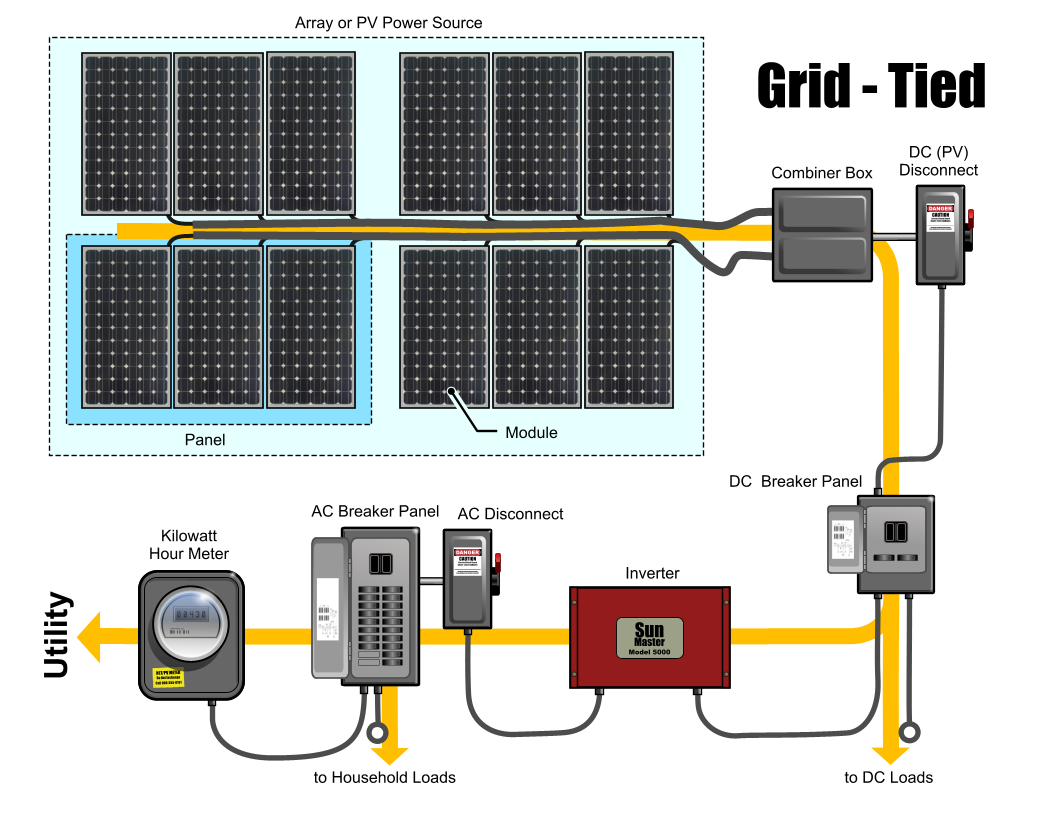

Energy Efficiency
We always recomend before making a large large investment purchase like solar, to make your home or business energy efficient first which lowers your overall monthly electric bill and then we can resize your system after the energy efficiencies have been put in place..
There are a number of efficient things you can do for you home or business, to many to list so here are the top ones to focus on.
- Spray foam insulation in the attic cuts down heat transfer from roof and allows your AC blower unit/coils to run more efficiently when it is cooler in the attic. Also adding blown in cellulose insulation to your attic space with keep the bugs and critters at bay while adding much needed energy efficiency
- Replacing outdated and older tank water heaters with electric or gas/propane On Demand tankless watewr heaters
- Replacing your outdated incandescent light bulbs with 1000% more efficient LED bulbs. Incandescent bulbs are only 10% light and the other 90% of energy use is wasted on heat. CFL or curly bulbs are being phased out due to the small amount of mercury in them that can be hazardous if broken. LEDs are last 10x as long as CFL bulbs as well.
- If your AC/Heating unit is over 20 years old, we recommend replacing it with a newer more efficient or Energy Star qualified unit. If you have a smaller house or cabin, we recommend Ductless or Split AC/Heating units. They come in single blower or up to 6 blowers for 6 rooms and share one outside condenser unit.
- In order to save water, you can install low flow shower heads (not with tankless units) or add solar thermal hot water system to your existing tank based water heater.

Off Grid Solar
An off-grid system has several different features as well. This type of solar electric system is not connected to the electrical grid. Instead, it relies on batteries to store the electricity generated by the solar panels for use when the system is not generating enough to sustain household functions, for example, at night. Because it is completely separate from the electrical grid, the power will remain on for the household or building even in the event of a widespread power outage; in a grid-tied scenario, the solar power system must shut off during a power outage for safety reasons. However, it is important to consider the space required to store the batteries, as well the added expense to purchase them. Additionally, off-grid systems cannot take advantage of SRECs, because the electricity never flows back to the utility grid.
- Independence is chief among the reasons for wanting an off-grid system where the grid is available
- Off-grid systems are not subject to the terms or policies of the local utility, nor are system owners subjected to rate increases, blackouts, or brownouts
- If you're shopping for rural property, you'll probably find that off-grid parcels are less expensive.
- off-grid systems tend to force you to use electricity efficiently
-
Easier to grow an off-grid system as you can afford it.
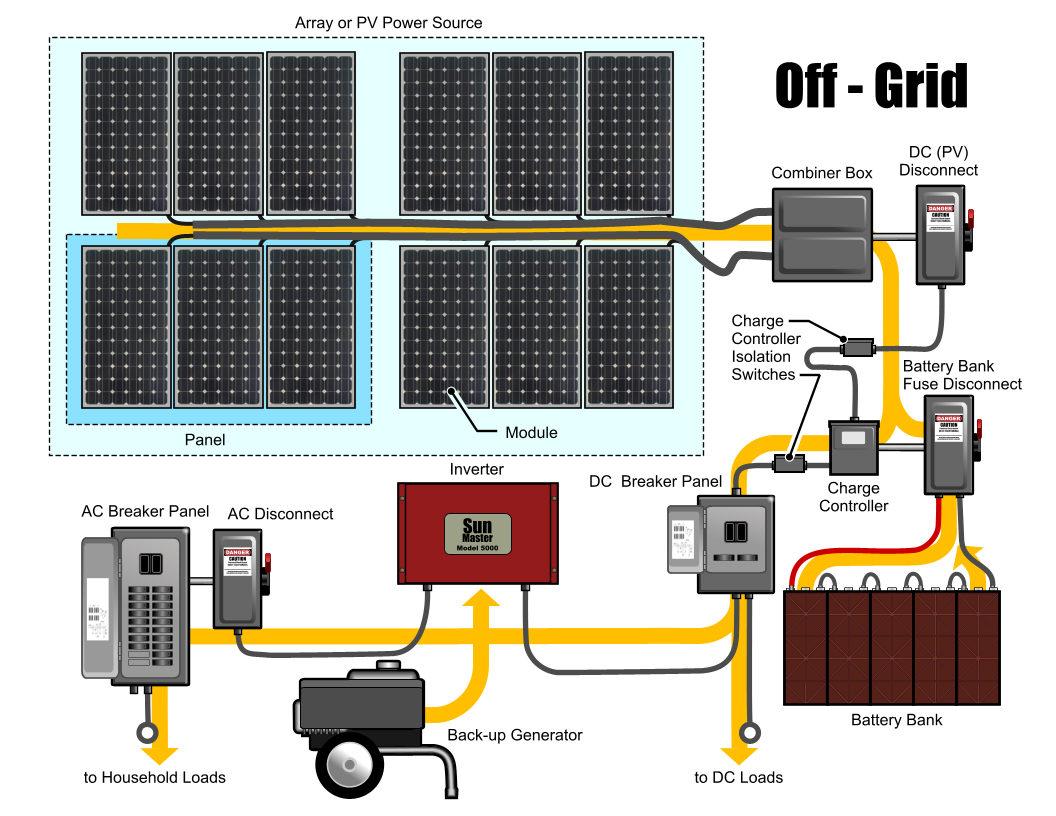

Mobile & Emergency Solar Systems
In the past two decades, non-disaster-related electricity blackouts have increased by 124% in the US. These numbers are further compounded by the increasing incidence of large disasters that knock out power for extended periods of time in the US and longer wait times before you see your electricity back on. Furthermore, lots of folks have been in situations where grid power is either not available or impractical at the location in need.
Portable solar generators and hybrid emergency backup systems can be solutions to the increasing power reliability issues. However, there are some key points that must be addressed for the success and efficiency of such products. These critical ideas include the current state of fuel-based generators, trends in solar, understanding kwh and electricity terminology, the benefits of solar power, rethinking your power usage, measuring that usage, incorporating hybrid systems for prolonged activity, and utilizing knowledge to make informed buying decisions.
- Mobile Solar Generators are basically small but efficient generators that are Off Grid systems and have the same components as Off Grid setups.
- Can be used for home lighting/house lighting, fridge or freezer backup power, remote area, mountainous area, desert area, grassland area, village, country area, camping, outdoor activities, travelling, lighting at night
- Developed to meet the off-grid power needs of environmentally conscious customers across a variety of industries including agriculture, construction, emergency/disaster relief, entertainment, events, and telecommunications.
- Sustainable - Uses the power of the sun to generate electricity for off-grid needs in military, disaster relief and remote location scenarios.
- No noise or fossil fuel pollution!!
Solar Tracking Systems
Solar trackers are rising in popularity, but not everyone understands the complete benefits and potential drawbacks of the system. Solar panel tracking solutions are a more advanced technology for mounting photovoltaic panels. Stationary mounts, which hold panels in a fixed position, can have their productivity compromised when the sun passes to a less-than-optimal angle. Compensating for this, solar trackers automatically move to "track" the progress of the sun across the sky, thereby maximizing output.
- Trackers generate more electricity than their stationary counterparts due to increased direct exposure to solar rays. This increase can be as much as 20 to 30% depending on the geographic location of the tracking system
- Solar trackers generate more electricity in roughly the same amount of space needed for fixed tilt systems, making them ideal for optimizing land usage
- There are many different kinds of solar trackers, such as single-axis and dual-axis trackers, all of which can be the perfect fit for a unique jobsite. Installation size, local weather, degree of latitude and electrical requirements are all important considerations that can influence the type of solar tracker best suited for a specific solar installation.
- Advancements in technology and reliability in electronics and mechanics have drastically reduced long-term maintenance concerns for tracking systems. GreenTechFusion focuses mainly on passive trackers that do not use actuators or electronics
- In certain states some utilities offer Time of Use (TOU) rate plans for solar power, which means the utility will purchase the power generated during the peak time of the day at a higher rate. In this case, it is beneficial to generate a greater amount of electricity during these peak times of day. Using a tracking system helps maximize the energy gains during these peak time periods
Get enough energy to satisfy your needs
Contact us today for a solar consultation!
Domestic Hot
Water Systems
Solar hot water systems and electric or propane/gas tankless hot water systems.
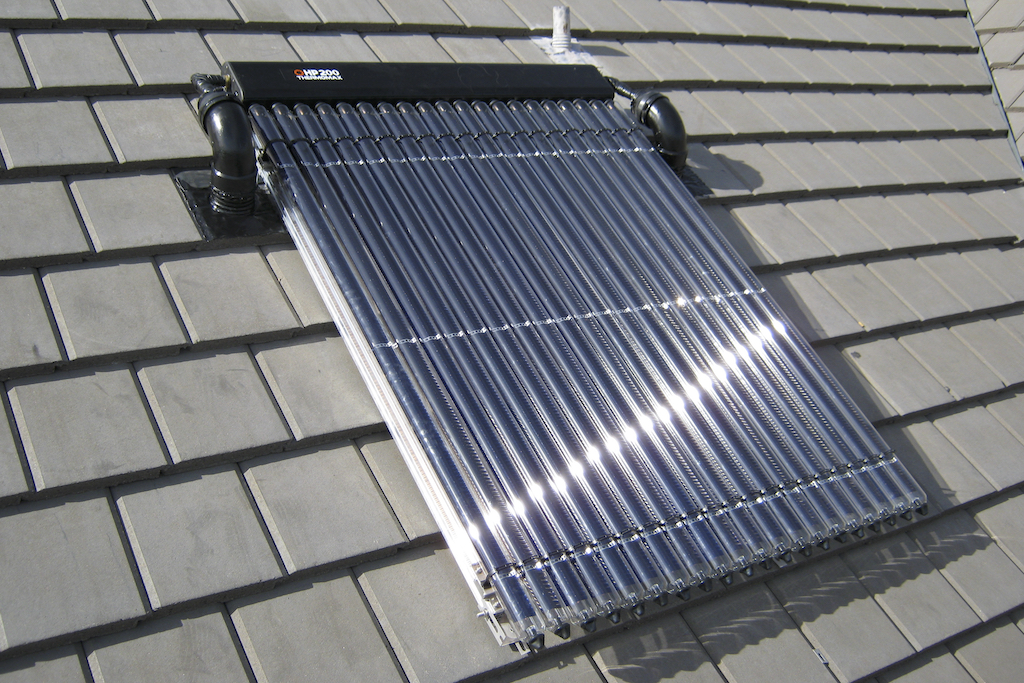
Solar thermal hot water systems can typically be cheaper overall than solar eletric system
Water heated by the sun is used in various ways. While perhaps best known in a residential setting to provide domestic hot water, solar hot water also has industrial applications, e.g. to generate electricity. Designs suitable for hot climates can be much simpler and cheaper, and can be considered an appropriate technology for these places. The global solar thermal market is dominated by China, Europe, Japan and India.
Tankelss hot water systems are becoming more popular in the USA and have been used in Europe and Asia for many years. Tankless systems are more efficient than tank base systems since they are not continually heating water and wasting energy. They are on demand systems and can be used in all electric or with propane or natural gas if preferred. Tankless electric systems are 220v AC and require quite a lot of electricity for short periods.
Integrated Collector Storage
Flat-plate and twin-tube evacuated collectors that are designed with the tank attached are also classified as ICS units. These designs depend upon thermosyphoning, where hotter liquids "rise" and colder "fall" as long as the storage tank is higher than the collector. ICS units are completely passive and don't depend on any moving parts or electricity to operate, though some contain electric water-heating elements for backup.
Thermosiphon
Thermosiphon (or thermosyphon) is a method of passive heat exchange, based on natural convection, which circulates a fluid without the necessity of a mechanical pump. Thermosiphoning is used for circulation of liquids and volatile gases in heating and cooling applications such as heat pumps, water heaters, boilers and furnaces.
Direct & Indirect Systems
Direct or open loop systems circulate potable water through the collectors. They are relatively cheap but can have drawbacks. Indirect or closed loop systems use a heat exchanger that separates the potable water from the fluid, known as the "heat-transfer fluid" (HTF), that circulates through the collector.
Passive & Acive Systems
Passive systems rely on heat-driven convection or heat pipes to circulate water or heating fluid in the system. Passive solar water heating systems cost less and have extremely low or no maintenance, but the efficiency of a passive system is significantly lower than that of an active system. Overheating and freezing are major concerns. Active systems use one or more pumps to circulate water and/or heating fluid in the system.
Drainback System
A drainback system is an indirect active system where the HTF (almost always pure water) circulates through the collector, being driven by a pump. The collector piping is not pressurized and includes an open drainback reservoir that is contained in conditioned or semi-conditioned space. If the pump is switched off, the HTF drains into the drainback reservoir and none remains in the collector. Since the system relies upon being able to drain properly, all piping above the drainback tank, including the collectors, must slope downward in the direction of the drainback tank.
